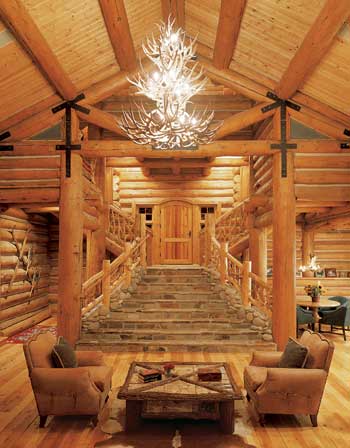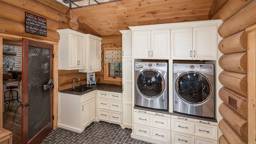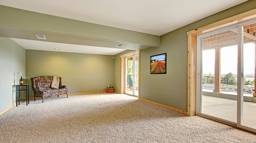 There's a reason why legendary rockers Led Zeppelin named their most famous tune "Stairway to Heaven." Not ladder to Heaven. Not walkway to Heaven. And certainly not escalator to Heaven.
There's a reason why legendary rockers Led Zeppelin named their most famous tune "Stairway to Heaven." Not ladder to Heaven. Not walkway to Heaven. And certainly not escalator to Heaven.
The fact is, there's just something romantic about staircases, as anyone who's seen Gone With the Wind can attest. Hundreds of years ago, skilled artisans built grand staircases admired for their elegant design and uncompromising quality. In fact, stairways were one of the more artistic features of a home.
But architecture has changed quite a bit since then. For a while, handcrafted, one-of-a-kind staircases gave way to more economical, space-saving systems.
But in the last decade or so, the classical and luxurious staircases of the past have made a comeback, with more home owners looking to design unique stairs that enhance a living area—or even become it's main focus.
These grand staircases are not for every home—or home owner. Some folks may still prefer a nononsense stairway that simply gets them from one floor to the next.
Either way, you'll have several important decisions to make when designing your perfect staircase. So just put one foot in front of the other and read on...
1 | TOP PRIORITY.
Unless you have a "dream" staircase in mind, chances are you'll be more focused on financing and floorplans in the beginning stages of your home buying process. But thinking about your stairs early could save you money in the long run. You'll be more apt to find the right product at the right price. And you'll get a leg up on related design and engineering considerations up front, with no need for "work-arounds" mid-project.
But what if you change your mind after construction begins? Many times, home owners will see a new idea in a magazine say, 'Is it too late to do this?' There's almost always a solution. You'll probably just have to spend some extra time and money to make it happen.
2 | PICK AND CHOOSE.
Structural integrity is a big factor when choosing stairway materials, but so are aesthetics, suggests Ryan Holman, owner of Ryan's Rustic Railings in Orr, Minnesota, who believes that log-style stairs work best in log homes, because "they carry on the rustic theme."
On the other hand, some argue that using different materials helps to draw attention to a home's individual characteristics. If you're interested in contrasts, consider pairing metal and wood for a refreshing design twist.
3 | FUNCTION FIRST.
Sam Cohen, sales manager for The Iron Shop in Broomall, Pennsylvania, says home owners should also be practical—taking into consideration how much abuse the stairway will take.
"Consider traffic flow," he says. "Make sure you pick a size and style that works with the amount of usage it will get."
When in doubt, go for rustic or reclaimed wood to hide wear and tear. Your builder may also be able to suggest another natural or man-made product that's attractive, affordable and resistant to scuffs.
4 | SIZE MATTERS.
"If you're tight on space, go with a spiral staircase," says Robert Maiaro, president of Mylen Stairs in Peekskill, New York. "If you need even more space, put it up against a wall. Want it to disappear? Put it in the corner."
Curved and circular stairs can be ideal for a loft because of the small footprint they take up. And larger spirals often lend a dramatic air, from elegant to organic, to any open living space.
But it's important to be practical, too. If your only staircase is a spiral—or if the other staircases in your home aren't a convenient distance from your front door, garage or laundry room—it could be difficult carrying larger loads from one floor to another.
5 | SAFETY FIRST.
Indeed, making sure your staircase is safe should be your top priority. Dan Schneider, owner of Log Stairways by Schneider Construction in Iola, Wisconsin, says "the hardest part of designing a log stairway is making sure it adheres to codes."
"This should be one of the first details you consider when designing your new staircase," suggests Sam Cohen, who says that building codes have had a big impact on how stairs have been built over the last few decades.
"Codes really affect your design freedom, but they also make it extremely difficult to install an unsafe stairway," he says.
For example, most building codes state a four-inch sphere must not be able to fit between the spindles or balusters—a sensible choice to protect small children. To keep everyone safe, there should also be equal spaces between each step to avoid a "trip step" that's higher or lower than the rest.
"Sometimes there's no one actively enforcing these codes, so it may be tempting to ignore them, adds Dan. "But I can't recommend strongly enough that you follow the rules."
6 | DO YOUR HOMEWORK.
The best way to guarantee you'll build the perfect stairway is to do a little legwork. There are plenty of sources to help you find what you like and rule out what you don't. Look through magazines and brochures—and visit several stair manufacturers' web sites.
Even if some of these companies are out of your budget or use different materials, you can still garner some inspirational design tips to share with the company or builder you do choose.
Once you've narrowed down your list, try to see all of the stair systems you're considering in person. The best way to do this is to visit showrooms and to attend trade or home shows.
Staircase manufacturers and dealers often exhibit at the Log and Timber Home Shows throughout the year. (See page 36 for the 2006 schedule.) Before each show, you can visit our web site at www.loghomedesignmag.com for a list of exhibitors.
7 | GUT INSTINCT.
After you do all your research and find a basic staircase style that works for your space and budget, the finer points of design are up to you.
"Just go by your eye," suggests Tad Horning, owner and artisan at StairMeister Log Works in Boulder, Colorado. "Stairs are works of art. Choose what you like. In the long run, it's all a matter of taste."
Indeed, it's the personal details that make a house a home. And sometimes, the most unique choices are also the most successful. By following your instincts, you'll design a staircase that takes your log home to the next level.











